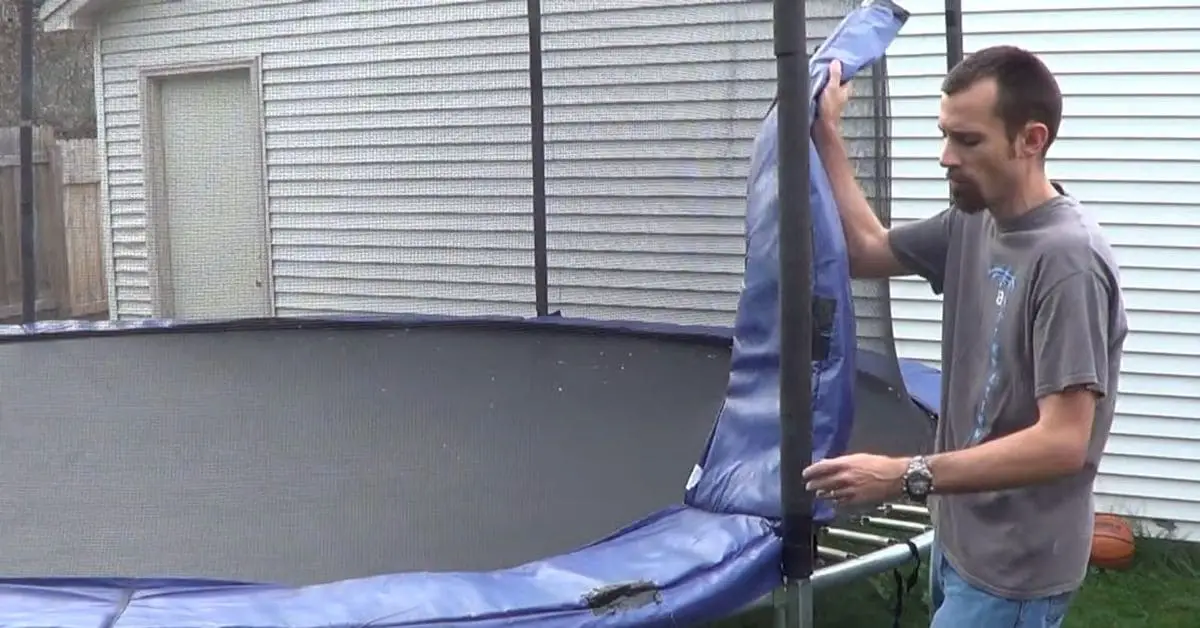If you’re like me, you may have had a trampoline in your backyard for years that has seen better days. Maybe your kids have grown up and moved out, or the trampoline isn’t being used as much as it used to. Whatever the reason, getting rid of a trampoline can be a daunting task. Not only do you need to disassemble the trampoline, but you also need to figure out what to do with all the parts.
Fortunately, removing a trampoline can be a manageable and even satisfying project with some planning and preparation. In this guide, I will share the steps and considerations you need to take to safely and efficiently get rid of your trampoline.
From preparation to transportation, I will walk you through removing your trampoline and provide options for responsibly disposing of it.
How to get rid of a trampoline:
Getting rid of an old trampoline can seem overwhelming, but with proper planning and execution, it can be a manageable project. Follow these steps to safely and efficiently remove and dispose of your trampoline responsibly.
Reasons to Get Rid of a Trampoline
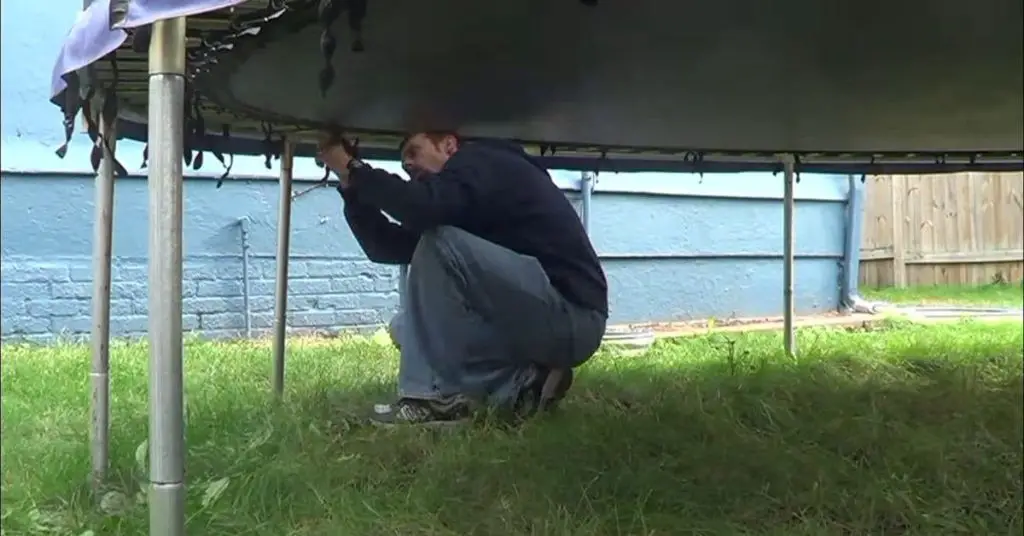
For several reasons, someone might want to get rid of a trampoline. Here are a few:
Safety concerns: Trampolines can be dangerous, particularly when not used properly or in poor condition. Accidents such as falls, collisions, and entrapments can result in serious injuries, especially for children.
Space limitations: Trampolines can take up a lot of space in a yard, which can be a problem for homeowners with limited outdoor space or wanting to use their yards for other purposes.
Maintenance and repair costs: Trampolines require regular maintenance and repair to stay in good condition, which can be costly and time-consuming.
No longer being used: If no one in the household uses the trampoline anymore, it may take up valuable space for no reason.
Benefits of removing a trampoline:
Increased safety: Removing a trampoline can help reduce the risk of accidents and injuries, particularly for children who may be using it unsupervised.
More usable space: Removing a trampoline can free up space in the yard, allowing homeowners to use the area for other activities, such as gardening or outdoor entertaining.
Reduced maintenance and repair costs: Homeowners can save time and money on upkeep without a trampoline to maintain and repair.
Improved aesthetics: A yard without a trampoline can look more organized and tidy, improving the property’s overall appearance.
How to get rid of a trampoline: Easy Steps
If you’ve decided that it’s time to get rid of your trampoline, you should follow a few steps to ensure that it is done safely and efficiently.
We’ll provide a step-by-step guide for removing a trampoline and information on free removal options, the cost of trampoline removal, and the tools you’ll need to get the job done.
Step 1: Disassemble the Trampoline
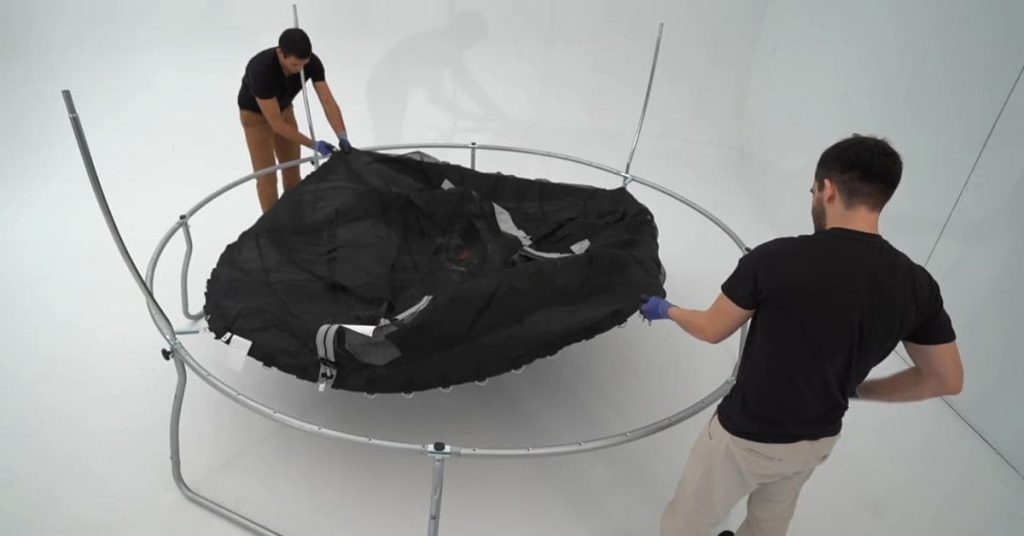
Before you can remove the trampoline, you’ll need to disassemble it. Remove the safety net if your trampoline has one, then remove the mat. Once the mat is removed, you can start taking the trampoline apart.
Step 2: Remove the Frame
The next step is to remove the frame of the trampoline. Start by removing the legs, then move on to removing the springs. Once the springs are removed, the frame can be taken apart.
Step 3: Decide How to Dispose of the Trampoline
Once the trampoline is disassembled, you’ll need to decide how to dispose of it. Several options include recycling the metal frame and springs, donating or selling usable parts, or bringing it to a junk removal service or landfill. Consider which option is best for you based on the condition of the trampoline and your personal preferences.
Step 4: Prepare the Trampoline for Disposal
Before you can dispose of the trampoline, you’ll need to prepare it for transport. This may involve disconnecting and removing the net and padding and gathering necessary tools and equipment for transporting the trampoline.
Step 5: Transport the Trampoline
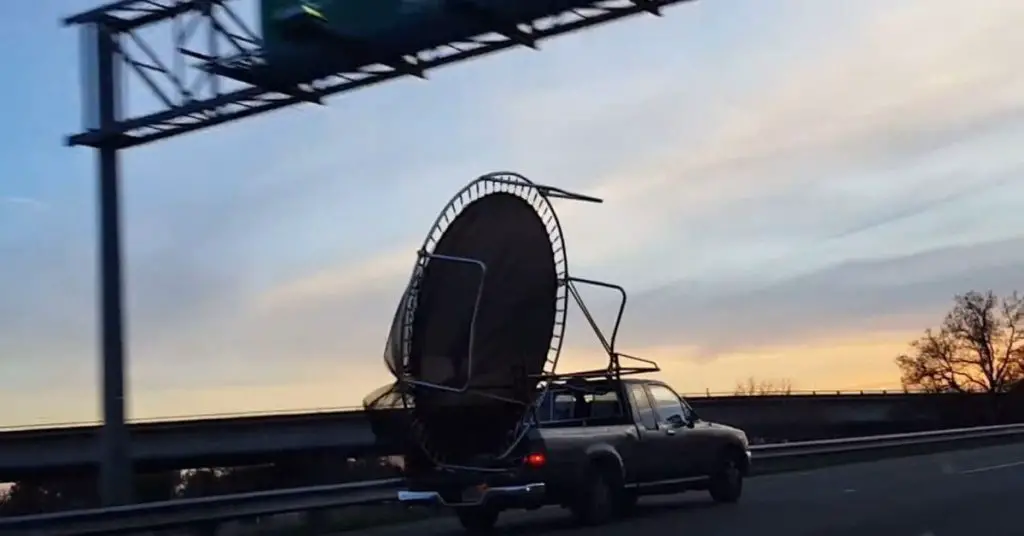
Once the trampoline is disassembled and prepared for disposal, you’ll need to transport it to its final destination. Depending on your chosen disposal option, this may involve renting a truck or trailer or hiring a junk removal service to pick up the trampoline.
Free Trampoline Removal Options
If you’re looking for a free option for trampoline removal, there are a few possibilities. You may be able to find a local scrap metal collector who will pick up the trampoline for free and recycle the metal frame and springs. Alternatively, you can try posting the trampoline on a local classifieds website or social media platform, offering it for free to anyone willing to remove it themselves.
Cost of Trampoline Removal
If you can’t find a free removal option, you may need to pay for trampoline removal. The cost of removal can vary depending on a number of factors, including the size of the trampoline, its condition, and the disposal option you choose. You can expect to pay between $100 and $200 for trampoline removal.
Trampoline Removal Tools
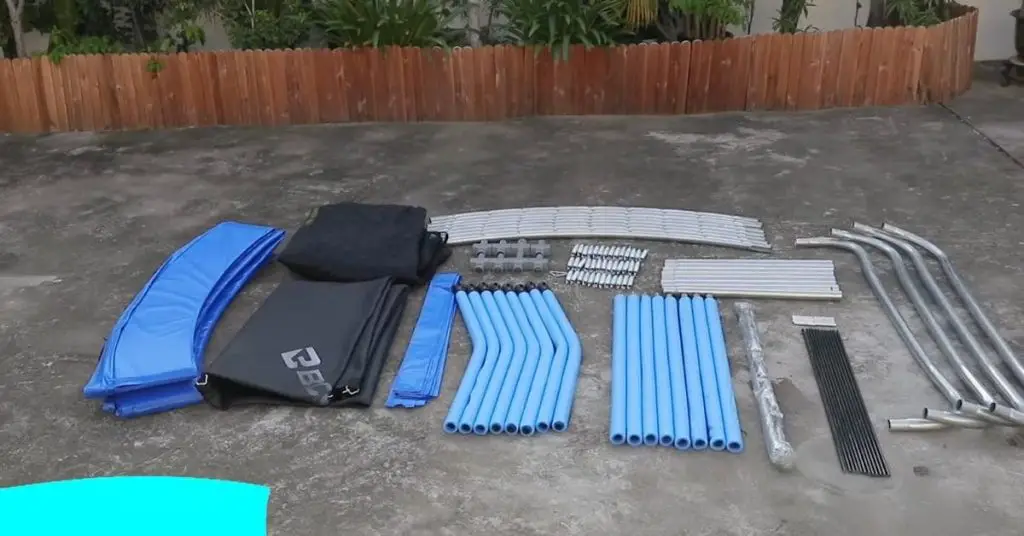
You’ll need a few basic tools to disassemble and remove a trampoline. These may include a socket wrench set, pliers, a rubber mallet, scissors, or a knife for cutting the mat and net. If you don’t already have these tools, you can purchase or rent them from a hardware store.
Disposal Options
Once a trampoline is fully disassembled and ready for disposal, there are several options for how to get rid of it. Depending on the condition of the trampoline and personal preferences, one of the following options may be suitable.
Recycling the metal frame and springs
One option for disposing of a trampoline is to recycle the metal frame and springs. Many scrap metal recycling facilities accept trampolines as scrap metal. The metal can be melted down and reused for other purposes, which is an environmentally friendly option.
It’s important to note that some recycling centers may require the trampoline to be disassembled and the springs and frame to be separated.
Donating or selling usable parts
If the trampoline is in good condition and only needs minor repairs, donating or selling usable parts may be possible. This is a great option for those who want to avoid sending the trampoline to a landfill and who want to save money on disposal costs.
Some people may be interested in buying a used trampoline for their backyard or a community center. It’s important to make sure that the trampoline is safe to use and to provide all necessary information about any repairs that have been made.
Bringing to a junk removal service or landfill
If the trampoline is no longer usable or cannot be repaired, it may be necessary to dispose of it at a landfill or through a junk removal service. This is generally the least environmentally friendly option, as trampolines take up a lot of space in landfills and can take a long time to decompose. However, it may be the only option for some people.
When choosing a junk removal service, it’s important to make sure that they are licensed and dispose of items responsibly.
It’s important to consider the environmental impact of disposing of a trampoline and to choose the most sustainable option.
Recycling the metal frame and springs, donating or selling usable parts, or choosing a responsible junk removal service can reduce the amount of waste that ends up in landfills. Additionally, by properly disposing of a trampoline, it’s possible to avoid potential hazards and safety risks.
Disassembly
Before disposing of a trampoline, it’s important to properly disassemble it. This involves taking apart the frame, removing the legs and springs, and deconstructing the mat. Here are the steps to follow for each of these tasks:
Removing the legs and springs
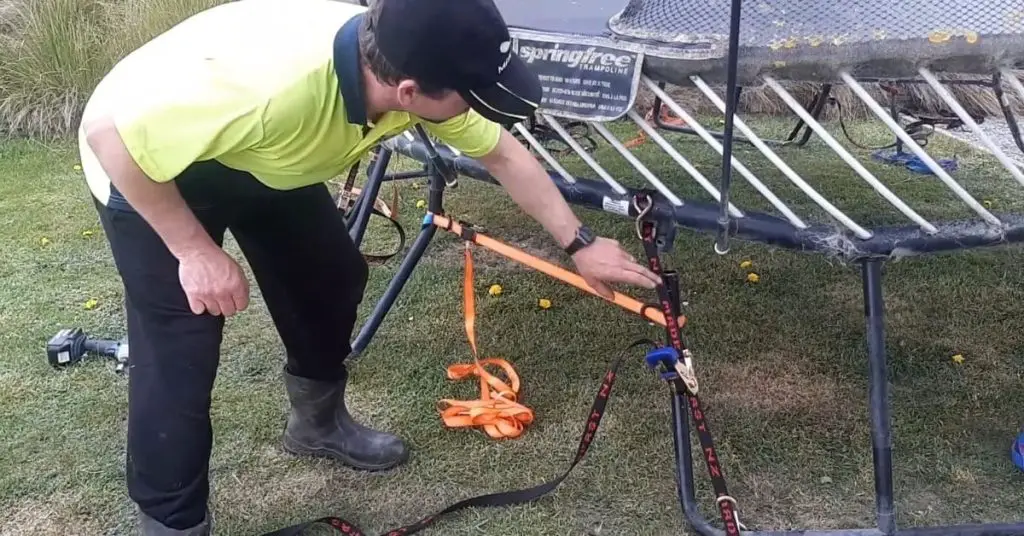
Start by disconnecting the springs from the mat. This can be done using a spring removal tool designed to safely and easily remove the springs. Once the springs are removed, you can then detach the legs from the frame.
This may involve unscrewing bolts or other fasteners that secure the legs in place. Make sure to keep all screws, bolts, and other small parts in a safe place so that they can be easily located later.
Taking apart the frame
After removing the legs and springs, you can begin disassembling the frame. This may involve unscrewing bolts or other fasteners that hold the frame together. Depending on the design of the trampoline, it may be necessary to use a socket wrench or other tools to remove certain parts. Keep all small parts safe so they can be easily located later.
Deconstructing the mat
The last step is to deconstruct the mat. This involves removing any padding, netting, or other materials that are attached to the mat. Once the mat is free of any other materials, it can be rolled up and disposed of separately. Check with your local waste management facility to determine the best way to dispose of the mat.
When disassembling a trampoline, it’s important to follow all safety precautions. Make sure to wear gloves and safety glasses to protect yourself from any sharp edges or flying debris.
If you’re unsure about how to safely disassemble a trampoline, consider hiring a professional to do it for you.
A professional will have the experience and knowledge needed to safely remove the trampoline without causing any damage to your property or posing any safety risks.
Preparation
Before you begin removing your trampoline, it’s important to prepare for it properly. This involves taking some safety considerations and ensuring that you have all the necessary tools and equipment. You should also be aware of the importance of proper disposal methods for trampolines.
Importance of proper disposal:
When disposing of a trampoline, choosing an environmentally friendly and safe method for others is important. Disposing of a trampoline improperly can have negative consequences on the environment and even result in legal repercussions. Therefore, it’s essential to be mindful of your chosen disposal method and follow the relevant regulations in your area.
Safety considerations:
Safety should be a top priority when removing a trampoline. The process involves dismantling the trampoline, which can be dangerous if not done correctly. Here are some safety tips to keep in mind:
- Wear appropriate safety gear, including gloves, eye protection, and closed-toe shoes.
- Use caution when removing parts of the trampoline to avoid injury from sharp edges and springs.
- Do not attempt to move or lift heavy trampoline pieces on your own. Always ask for help from others.
- Keep children and pets away from the area where you remove the trampoline.
Disconnecting and removing the net and padding:
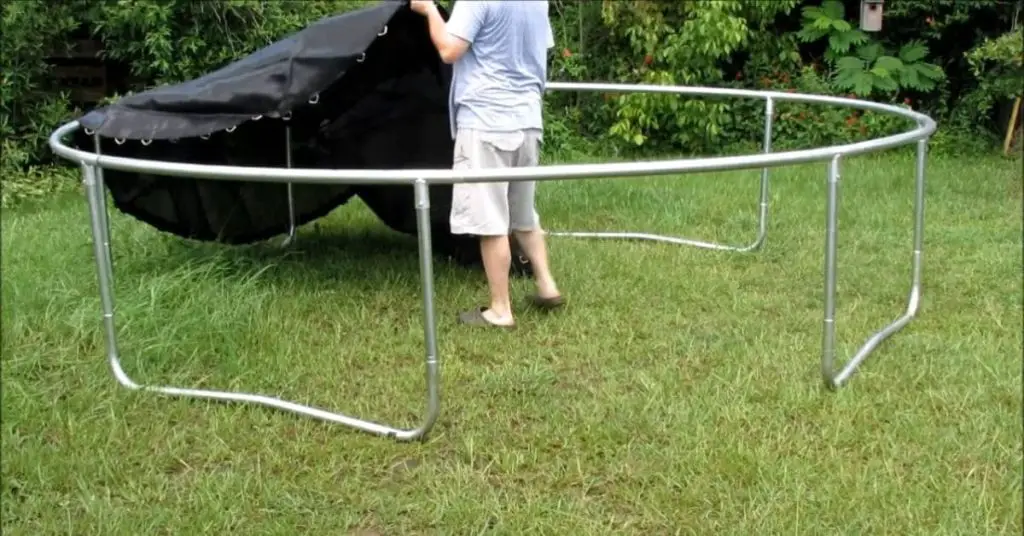
Before you begin disassembling the trampoline, it’s important to remove the net and padding. Start by removing the clips that hold the net to the poles or frame of the trampoline. Once the clips are removed, you can slide the net off the poles or frame. If your trampoline has padding, you can remove it by unzipping it from the mat and sliding it off.
Gathering necessary tools and equipment:
To safely and efficiently remove a trampoline, you’ll need the following tools:
- Socket wrench set or adjustable wrench
- Pliers
- Wire cutters
- Screwdriver
- Rubber mallet
- Safety gear (gloves, eye protection, closed-toe shoes)
You may also need a ladder or stool if your trampoline is elevated and a trailer or truck to transport the trampoline to a disposal site.
Overall, proper preparation is key to safely and efficiently removing a trampoline. Ensure you follow safety precautions, have the necessary tools and equipment, and choose a proper disposal method to ensure the process goes smoothly.
Final Steps
Once the trampoline has been successfully removed and transported, a few final steps still need to be taken to ensure that the area is safe and secure.
Cleaning up the Area:
The first step is to clean up the area where the trampoline was located. This includes removing any debris or litter that may have accumulated over time and sweeping or raking the area to remove any leaves or other loose materials.
Filling in the Holes Left by the Legs:
If the trampoline was set up with legs that were pushed into the ground, several holes might be left where the legs were located. These holes can pose a tripping hazard, so filling them in with soil or sand is important to make the area level and safe.
Taking Precautions to Avoid Future Accidents:
Even though the trampoline is gone, there may still be potential hazards in the area where it was located. For example, the ground may be uneven, or rocks or other obstacles could cause injury. To avoid accidents, it’s a good idea to fence off the area or place warning signs to alert people of potential hazards.
In addition, if you plan on setting up another trampoline in the future, it’s important to take the necessary precautions to prevent accidents. This includes choosing a level area to set up the trampoline, securing it with an enclosure or safety net, and following all manufacturer’s instructions for safe usage.
Overall, getting rid of a trampoline can be a bit of a hassle, but it’s worth the effort to ensure the safety of your family and neighbors. Following the steps outlined in this guide, you can safely and efficiently remove your trampoline and enjoy peace of mind knowing that you’ve taken the necessary steps to prevent accidents and injuries.
What to Do With Old Trampolines
Trampolines can provide endless hours of fun and entertainment, but eventually, they may need to be replaced or disposed of. When it’s time to get rid of an old trampoline, it’s important to do so responsibly and consider the various options available. We’ll explore what you can do with old trampolines and the available recycling and donation options.
Recycling Options
One option for disposing of an old trampoline is to recycle it. Many trampoline components can be recycled, including the metal frame and springs. These materials can be repurposed and used in other products, reducing the amount of waste in landfills.
When looking for a recycling option, check with your local recycling center or waste management facility to see if they accept trampolines. Some recycling centers may require the trampoline to be disassembled before recycling, so follow proper disposal protocols.
Donation Options
If your trampoline is still in good condition, consider donating it to a local charity or organization. There may be local youth centers, schools, or sports teams that would appreciate a donated trampoline.
Additionally, some organizations accept used trampolines for donation to families in need. Before donating, be sure to check with the organization to ensure they are able to accept the trampoline and to inquire about any requirements or restrictions they may have.
Can Trampoline Frames be Recycled?
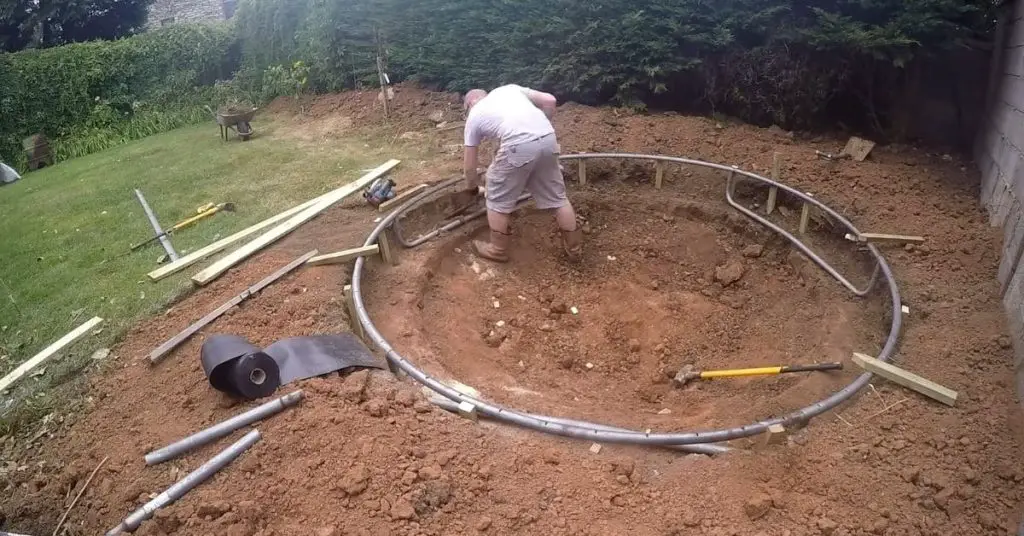
Trampoline frames can often be recycled, but checking with your local recycling center or waste management facility is important to ensure they accept them. When recycling the frame, remove all non-metal components, such as padding and netting, to ensure the frame can be recycled properly.
In addition to recycling and donation options, it’s important to remember that not all trampolines must be disposed of. Depending on the condition of the trampoline, some parts may be salvaged and repurposed. For example, the springs or frame could be used for other DIY projects or repairs.
FAQs
Q.1 Why should I get rid of my trampoline?
There are many reasons to consider getting rid of a trampoline, including safety concerns, lack of use, and the need for more space in your yard.
Q.2 How much does it cost to remove a trampoline?
The cost of removing a trampoline can vary depending on your location and disposal method. Some services may offer free removal, while others may charge a fee.
Q.3 n I recycle my trampoline?
Yes, you can recycle your trampoline. The metal frame and springs can be recycled at a metal recycling facility, while the mat and net may be able to be repurposed or recycled in some areas.
Q.4 How do I safely disassemble a trampoline?
To safely disassemble a trampoline, you should remove the net and padding, disconnect the springs, and remove the legs. Use caution when working with the metal frame and springs to avoid injury.
Q:5 What should I do with the leftover parts after disassembling my trampoline?
The leftover parts from disassembling a trampoline can be recycled, donated, or disposed of at a junk removal service or landfill.
Q. 6 How can I transport my trampoline after disassembling it?
To transport a disassembled trampoline, you can use a truck or trailer to haul the frame and parts to a recycling facility, donation center, or landfill. Be sure to secure the parts properly to avoid damage or injury during transportation.
Q.7 Can I donate my old trampoline?
Yes, you can donate your old trampoline if it is in good condition. Some charities or community centers may accept trampoline donations for use in their programs.
Conclusion
In conclusion, getting rid of a trampoline can be wise for various reasons. Removing a trampoline can create more space in your yard and eliminate potential hazards that can cause injuries. Getting rid of a trampoline involves several easy steps, including disassembling the trampoline, removing the frame, deciding on the disposal method, preparing the trampoline for disposal, and transporting it to the chosen disposal location.
There are several options for disposing of an old trampoline, including recycling the metal frame and springs, donating or selling usable parts, bringing it to a junk removal service or landfill, and disassembling it.
Safety considerations are essential when removing a trampoline, including disconnecting and removing the net and padding, gathering the necessary tools and equipment, and cleaning up the area. Filling in the holes left by the legs and taking precautions to avoid future accidents are crucial steps.
Depending on their condition, there are several options for recycling and donating old trampolines. Recycling the metal frame and springs is an eco-friendly option while donating or selling usable parts can be a great way to repurpose the trampoline.
Proper disposal methods allow you to get rid of your old trampoline safely and efficiently, creating a safer environment for your family and others.
We hope you have learned how to get rid of a trampoline by reading this guide. If you have any questions, please ask in the comments section below!

